
Eradicate Neck Pain: Essential Forward Head Posture Exercises
Are you tired of managing persistent neck pain? If so, you're not alone. Many people suffer from constant neck discomfort caused by forward head posture, a common issue in today's digital age. But don't worry because relief is within reach. This article will guide you through essential forward-head posture exercises to help you fix forward-head posture and eradicate neck pain for good.
Our brand promotes a healthy lifestyle and empowers individuals to take control of their well-being. With that in mind, we have compiled a comprehensive guide to tackling forward head posture and its associated pain. You'll learn how to realign your posture, strengthen the supporting muscles, and alleviate the strain on your neck through targeted exercises and stretches.
Don't let neck pain hold you back any longer. Join us as we dive into the world of forward head posture exercises and unlock the key to a pain-free life. Your neck will thank you!
Understanding Forward Head Posture

Forward head posture, also termed as "text neck" or "nerd neck," refers to when the head protrudes forward out of alignment with the thoracic spine and an excessive rounded shoulders. This condition is often caused by prolonged periods of sitting, hunching over electronic devices, or poor posture habits. When the head is consistently held in this position, it places excessive strain on the neck muscles, leading to pain and discomfort.
Symptoms
Recognizing the symptoms of forward head posture is crucial in addressing the issue. Some common signs include:
- Persistent neck and shoulder pain and stiffness
- Headaches, particularly at the base of the skull
- Aching or tightness in the upper back and shoulders
- Reduced range of motion in the neck
- Tingling or numbness in the arms or hands
- Poor posture with the head jutting forward
If you experience any of these symptoms, correcting your forward head posture and preventing further complications is essential.
Is Forward Head Posture Correctable?
The good news is that forward head posture is correctable with the right exercises and techniques. By actively improving your posture and strengthening the supporting muscles, you can gradually realign your forward head position with your spine and alleviate the pain and discomfort.
However, it's important to note that correcting forward head posture requires consistency, patience, and a holistic approach. While exercises play a crucial role, it's equally crucial to address any underlying causes, such as poor ergonomics or lifestyle habits, that contribute to the issue.
Impact on Neck Pain
Understanding how forward head posture impacts neck pain is critical to addressing the issue effectively. When the head is positioned, the weight of the skull increases, placing additional strain on the muscles, ligaments, and joints of the neck. Over time, this may result in muscle imbalances, weakened supporting muscles, and increased pressure on the spinal discs.
The resulting neck pain can range from mild discomfort to chronic, debilitating pain. It may also contribute to tension headaches, reduced range of motion, and nerve impingement.
Correcting forward head posture and strengthening the supporting muscles of the cervical spine can reduce the strain on your neck and alleviate the associated pain. Let's dive into the essential exercises to help you achieve a pain-free neck.
Importance of Exercises

Exercise plays a critical role in correcting forward head posture. By engaging in targeted exercises and stretches, you can improve forward head posture, strengthen the muscles that support proper posture, and reduce the strain on your neck. Regular exercise also improves circulation, promotes flexibility, and helps prevent muscle imbalances.
Integrating stretches and strength-building exercises into your routine, like neck stretch, neck flexion, wall angle, and shoulder blade squeeze, is essential to achieve optimal results. Stretching exercises focus on elongating and releasing tight muscles while improving exercises target the muscles that support good posture.
Combining these exercises will correct your forward head posture and tension neck syndrome, improve your overall posture, and minimize the risk of future neck pain.
1. Chin Tuck
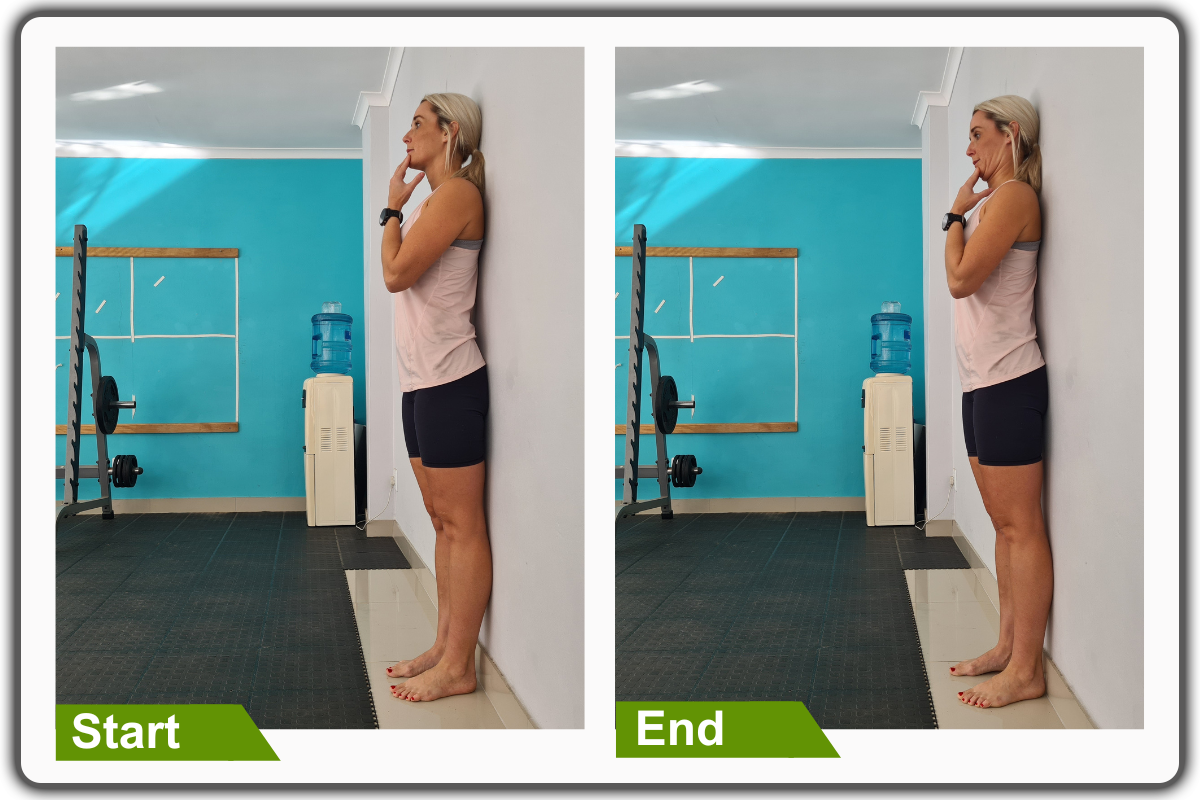
Begin in an upright standing position with your feet shoulder-width apart, maintaining a good alignment with your head, shoulders, hips, and legs. It elongates your spine and opens your chest and shoulders. Slightly shift your head back and retract your chin inward, creating a 'double chin.' Hold this position for 2 – 5 seconds. Relax and repeat the movement.
2. Pectoral Stretch
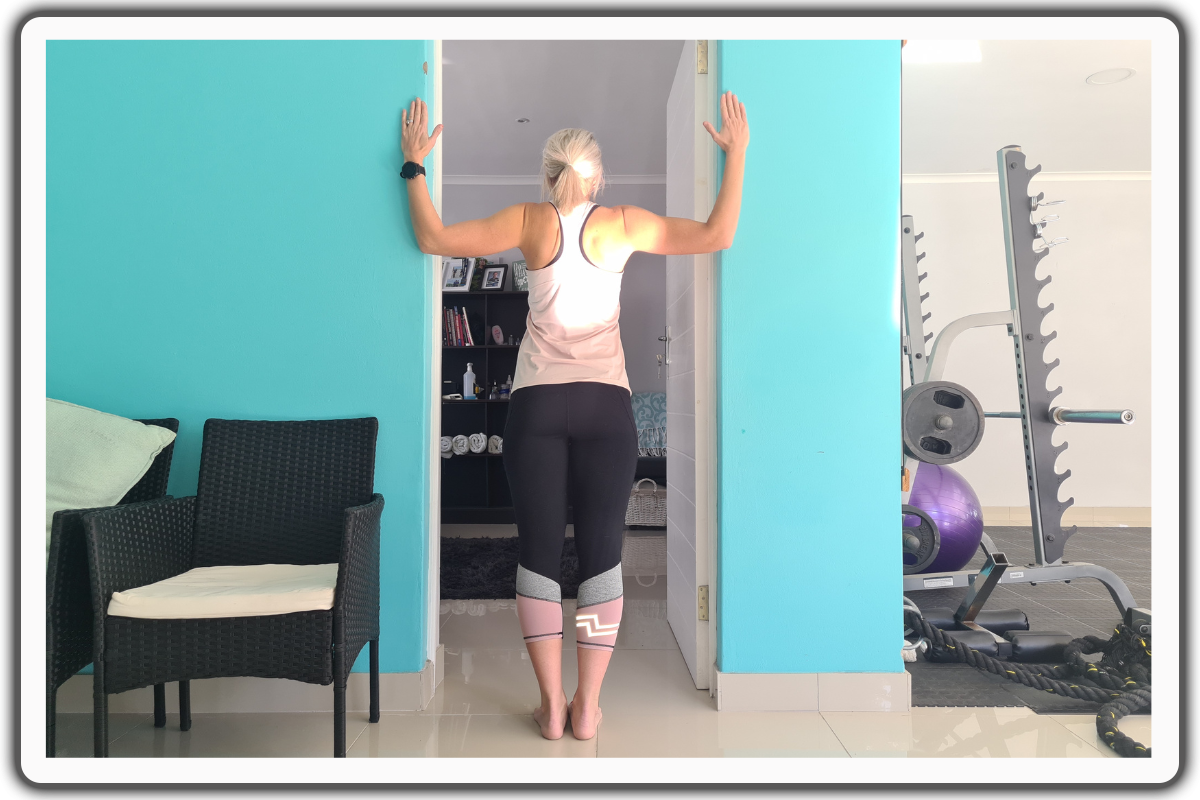
Begin in an upright standing position in the middle of the door frame with your feet shoulder-width apart, maintaining a good alignment with your head, shoulders, hips, and legs. Raise your arms out at your sides to shoulder height with both elbows bent at 90-degree angles, keeping your elbows and forearms pressed against the door frame. Lean forward until you feel a gentle stretch in front of your chest and shoulders. Hold this position for 30 seconds. Perform this movement for 1 set of 1 to 3 repetitions.
3. Thoracic Extension On Foam Roller
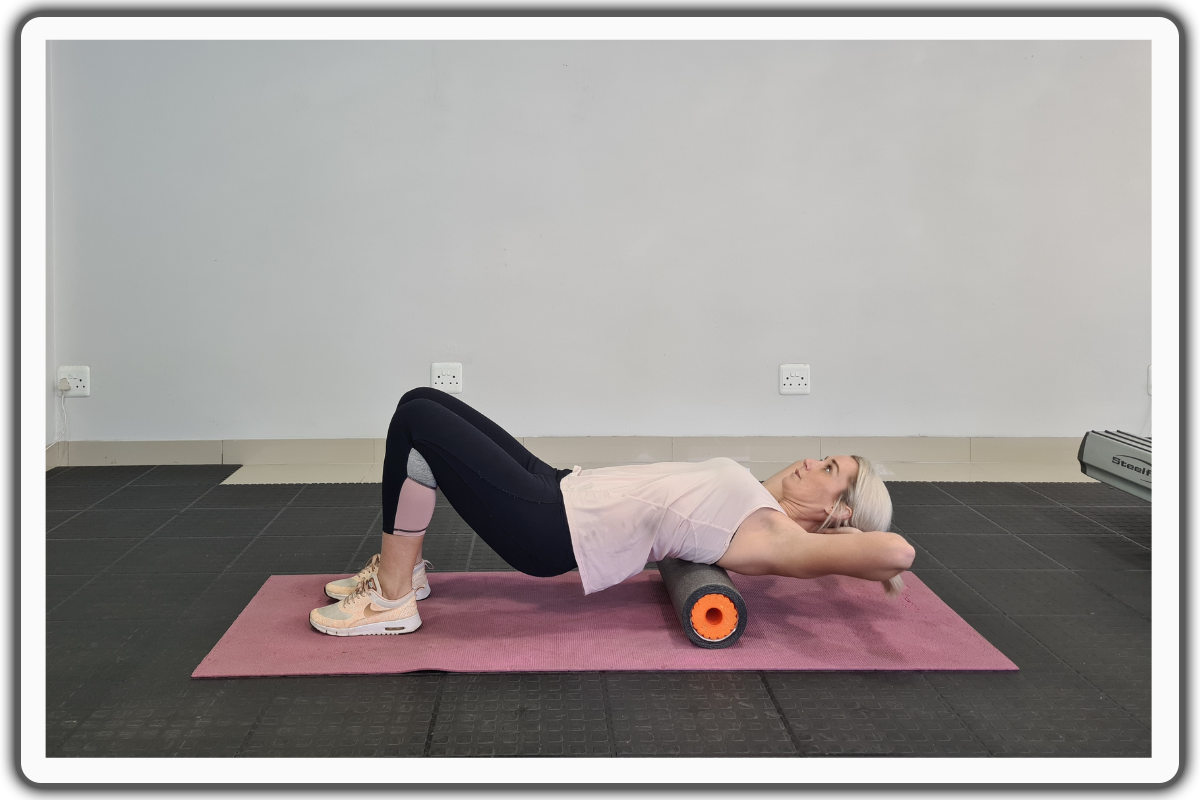
Lie on your back on the floor with your knees bent and your heels on the floor. Place the foam roller under your upper back, lifting your upper body and maintaining good alignment with your head, shoulders, and hips. Bring both of your hands under your head, letting your head fall back. Run the foam roller from your midback to the base of your neck and back. Repeat the movement. Perform this movement for 1 to 2 sets of 1 to 3 repetitions.
4. Cat-Cow
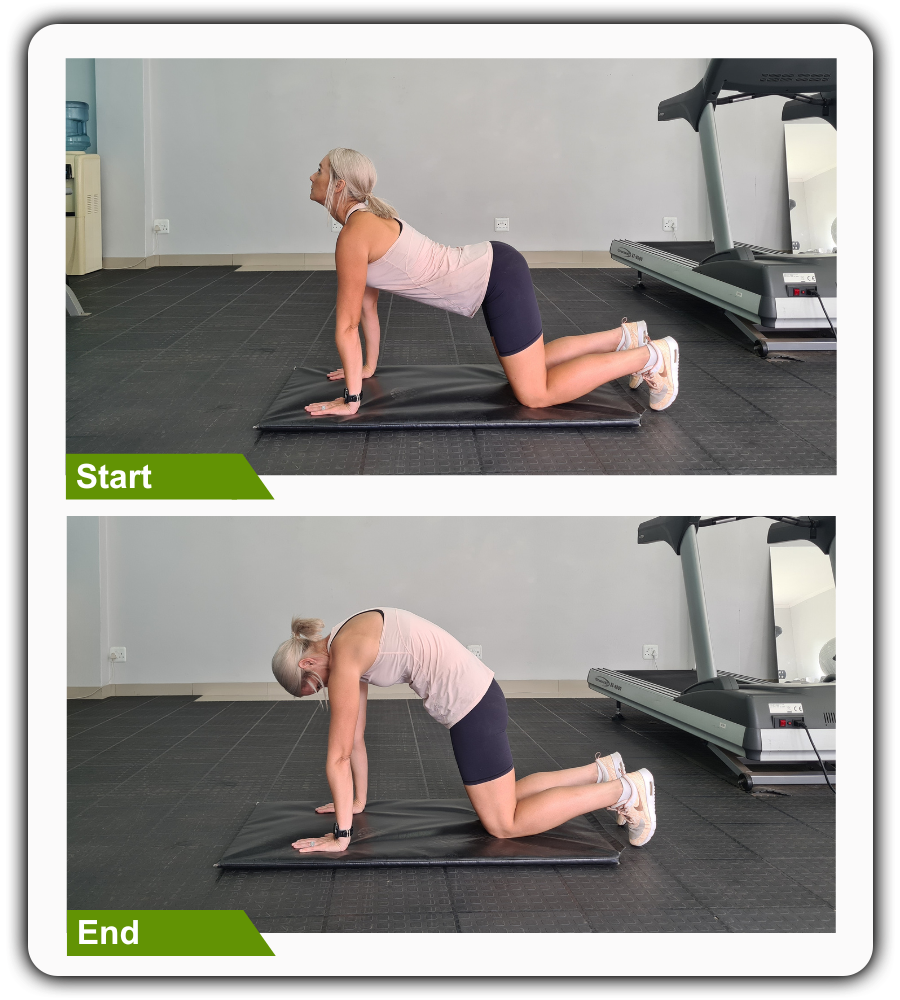
Begin in a 4-point position with your hands beneath your shoulders and your knees under your hips. Engage your core and slowly round out your mid-back as you drop your head downward. Then, alternate by inhaling as you slowly lift your head and arch your mid-back. Repeat the movement, alternating directions. Complete 5 repetitions.
5. Child's Pose
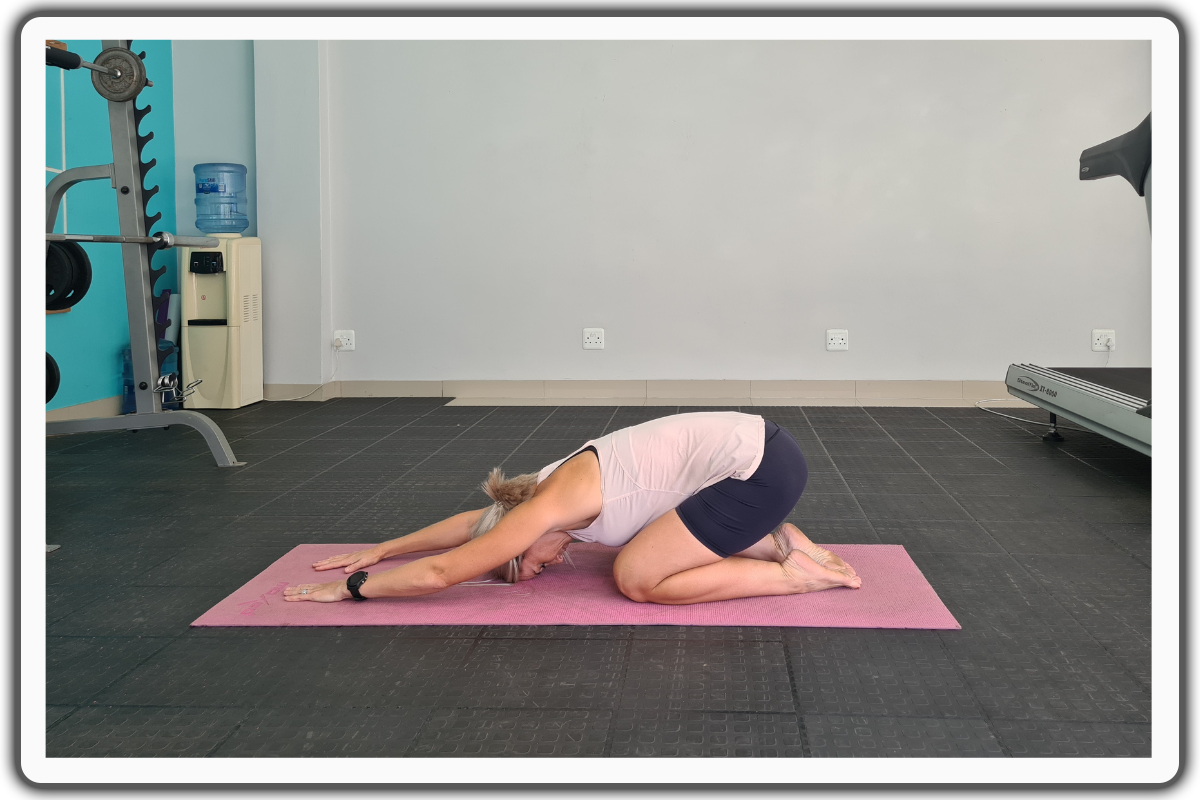
Begin in a 4-point position with your hands beneath your shoulders and your knees under your hips. Tighten your abdominal area and widen your knees. Shift your hips back to your feet and place your arms overhead. Lower your forehead to your forearms and relax your mid-back area for a light stretch. Hold this position for several deep belly breaths through your nose and mouth. Relax and return to the starting position.
Posture Correction Techniques and Tips

In addition to exercises, you can incorporate several techniques and tips into your daily life to correct forward head posture and maintain good posture overall.
Practice Proper Ergonomics
Make sure your workspace, comprising your desk, chair, and computer arrangement, is designed ergonomically to encourage good posture. Adjust your monitor height, chair position, and keyboard placement to maintain a neutral spine and avoid hunching forward.
Take Regular Breaks
Prolonged periods of sitting or utilizing electronic devices can contribute to forward head posture. Incorporate frequent breaks to stretch, walk, and move around. Set reminders to check your posture and make adjustments as needed.
Use a Supportive Pillow
Invest in a supportive pillow that promotes proper spinal alignment while sleeping. Avoid pillows that are too high or too low, as they can contribute to poor posture and neck pain.
Engage in regular Physical Activity
Regular physical activities like walking, swimming, or practicing yoga can contribute to good posture. Strive for a minimum of 30 minutes of exercise with a moderate level of intensity on the majority of days throughout the week.
Be Mindful of your Posture
Be mindful of your posture throughout the day, and consciously try to sit and stand tall. Picture a string gently lifting the crown of your head towards the ceiling, aligning your spine, and keeping your head in a neutral position.
Incorporating these techniques and tips into your daily routine will complement the forward head posture exercises and help you maintain good posture for the long term.
Lifestyle Changes to Prevent and Manage Forward Head Posture

Preventing and managing forward head posture goes beyond exercises and stretches. Implementing particular adjustments to your lifestyle can have a substantial effect on both your posture and overall state of well-being.
- Limit screen time - Reduce your time on electronic devices, especially those that require you to look down for extended periods. Make sure to take breaks consistently and adhere to the 20-20-20 guideline: every 20 minutes, take a 20-second break and redirect your focus to something situated 20 feet away.
Practice mindfulness and stress reduction techniques - Stress can contribute to poor posture and muscle tension. Integrate mindfulness, meditation, or deep-breathing practices into your daily schedule to alleviate stress and foster a sense of relaxation.
Maintain a healthy weight - Excess weight can strain the muscles and joints, including the neck and upper back. Manage your weight effectively by adopting a well-rounded diet and engaging in consistent exercise to minimize the likelihood of developing postural problems.
Get regular Check-ups - Timely consultations with a healthcare professional, like a chiropractor or physical therapist, can assist in recognizing and addressing any postural issues before they become chronic problems.
By incorporating these adjustments to your lifestyle, you can proactively move towards preventing and managing forward head posture, promoting good posture, and reducing the risk of neck pain.
Conclusion
Forward head posture frequently results in neck pain, a common issue affecting many individuals in today's digital age. However, with the proper knowledge and exercises, you can eradicate this pain and improve your overall well-being.
Understanding the significance of forward head posture about neck pain is essential to address the problem effectively. By fixing forward head posture and incorporating stretching and strengthening exercises, you can realign your head with your spine, strengthen the supporting muscles, and alleviate strain on your neck.
Remember to incorporate good posture habits into your daily routine, make necessary lifestyle changes, and be consistent. With time and dedication, you can achieve a pain-free neck and enjoy the benefits of improved posture and overall health.
So, don't let neck pain hold you back any longer. Take control of your well-being and embark on a journey to eradicate neck pain with essential forward head posture exercises. Your neck will thank you!
